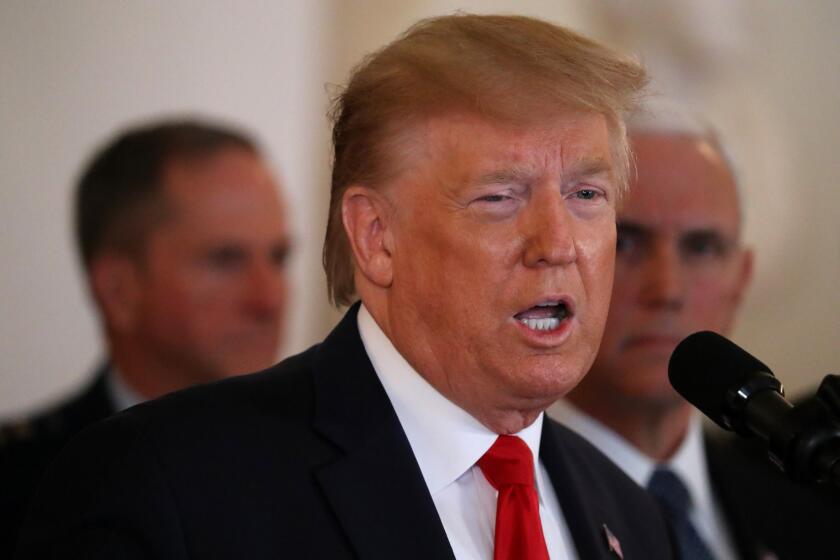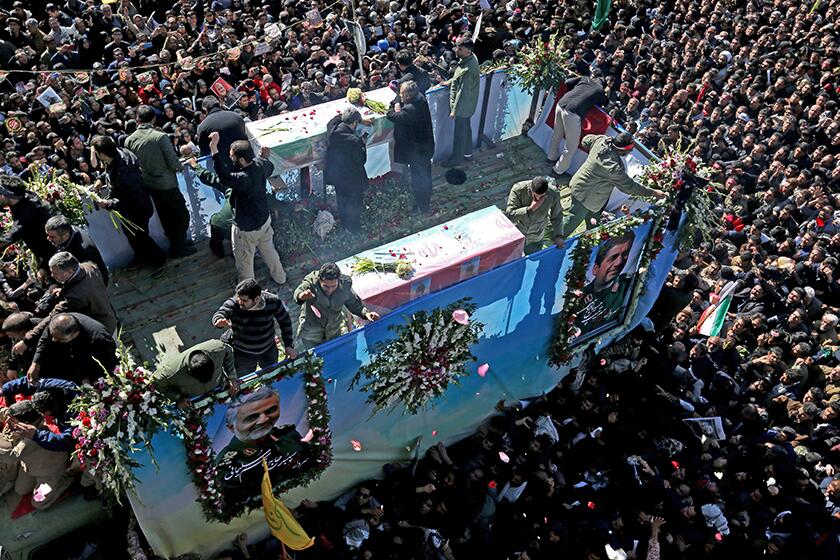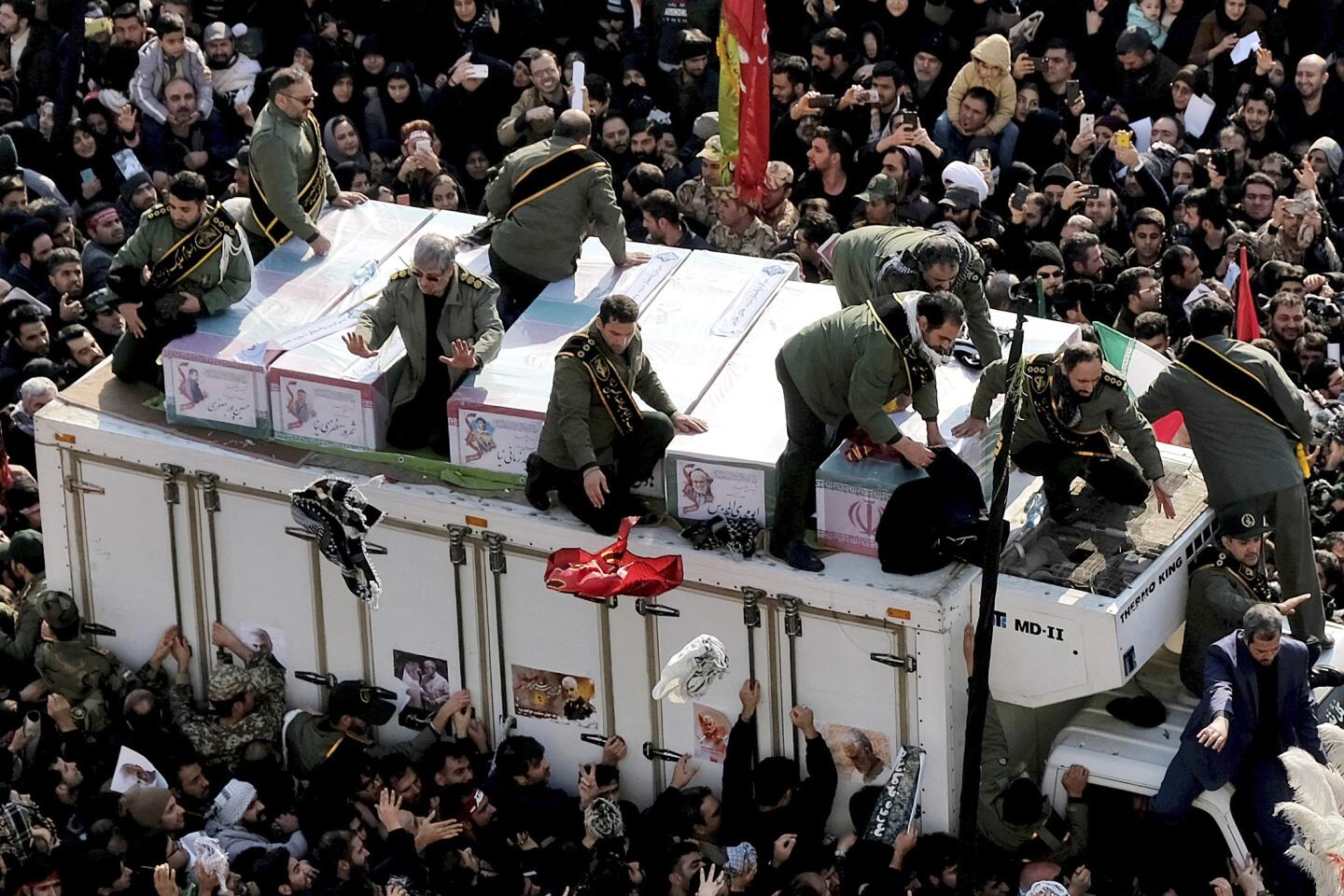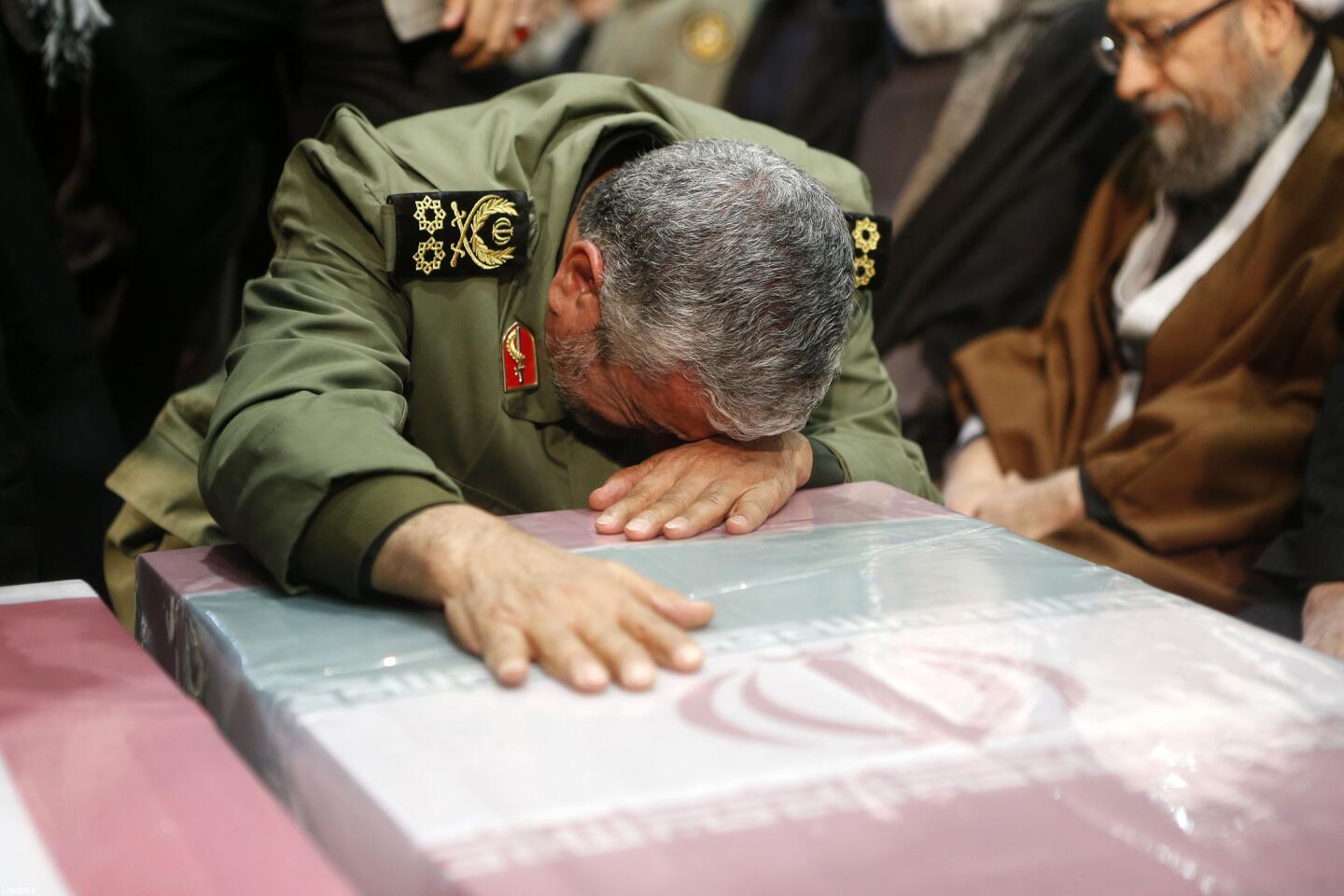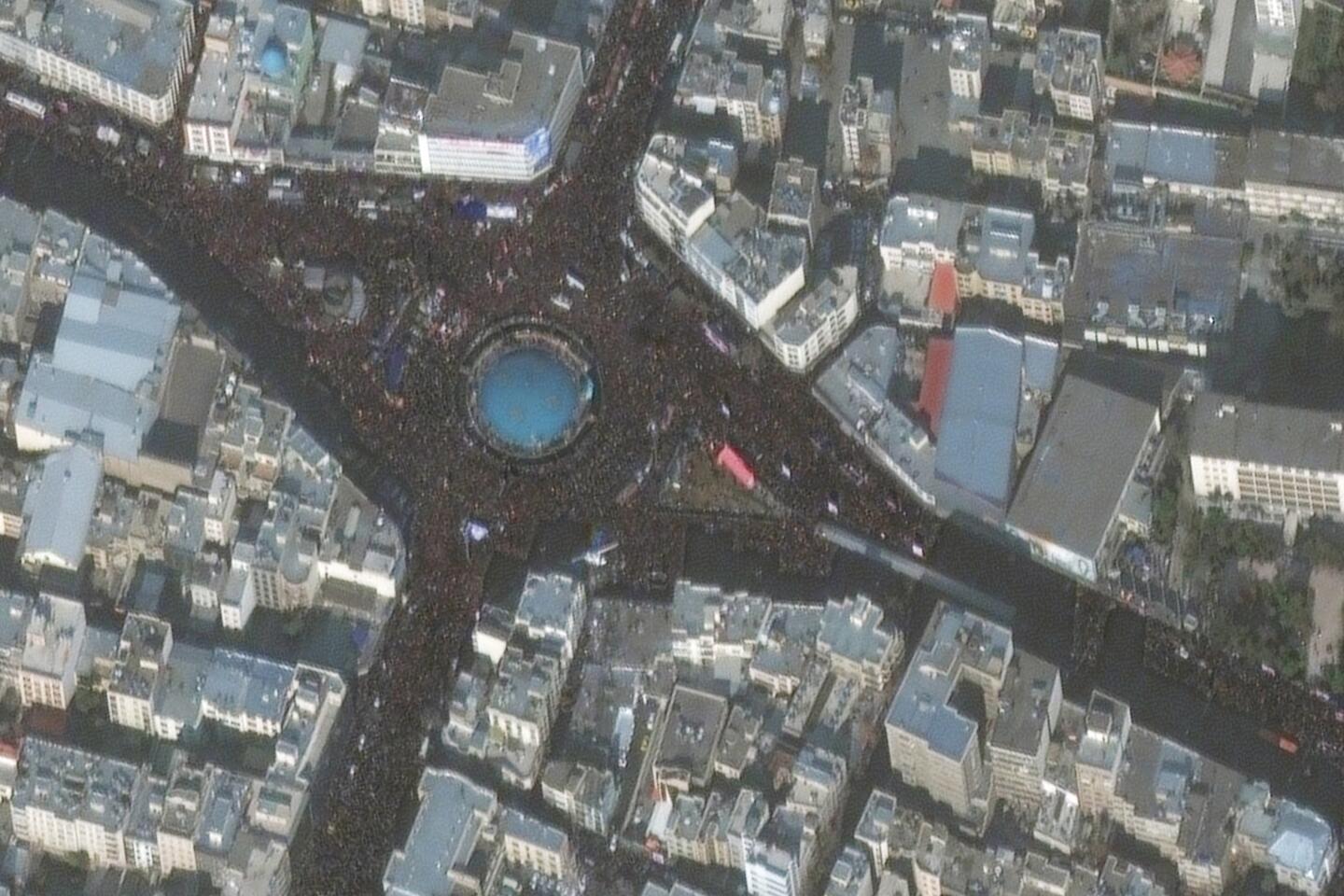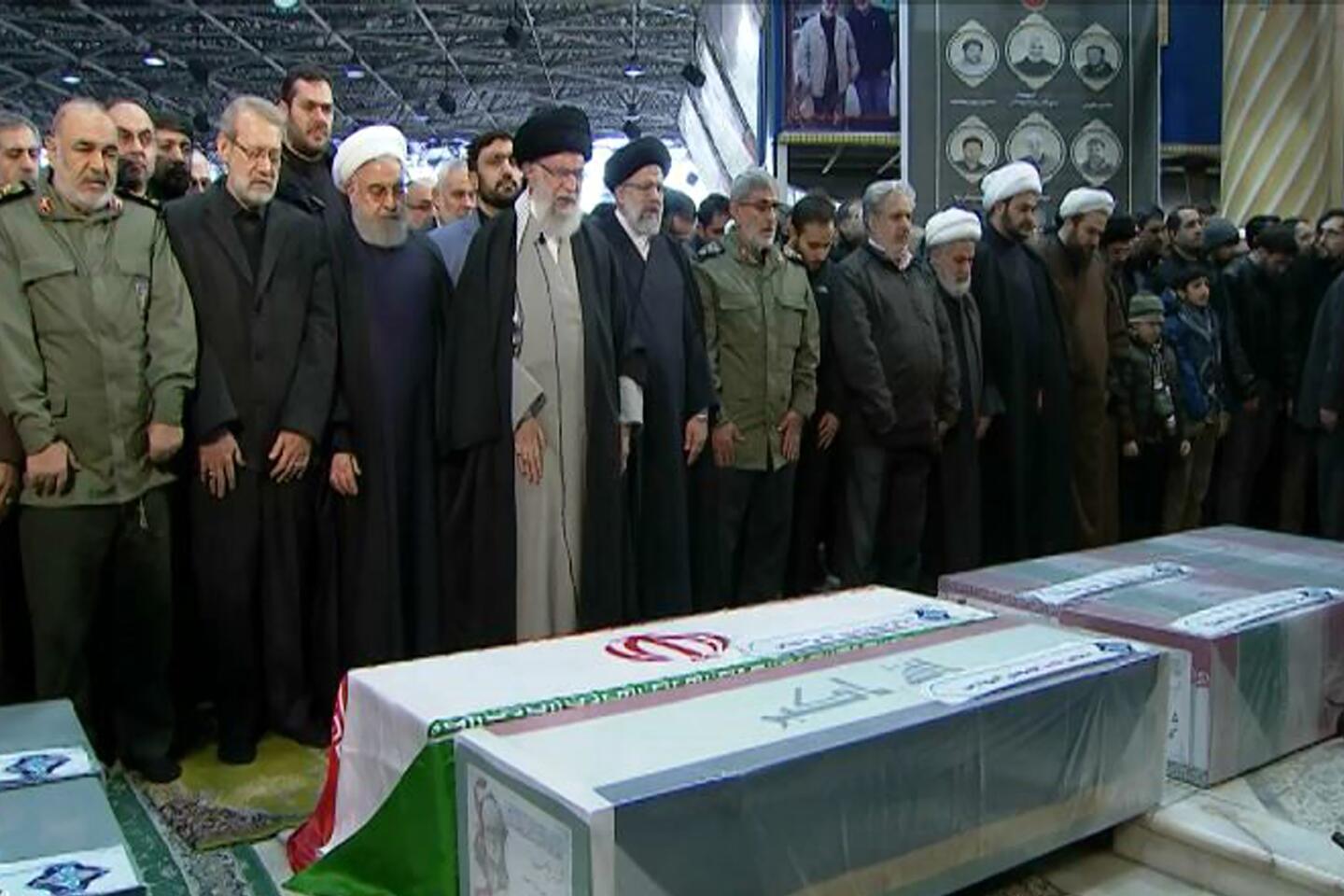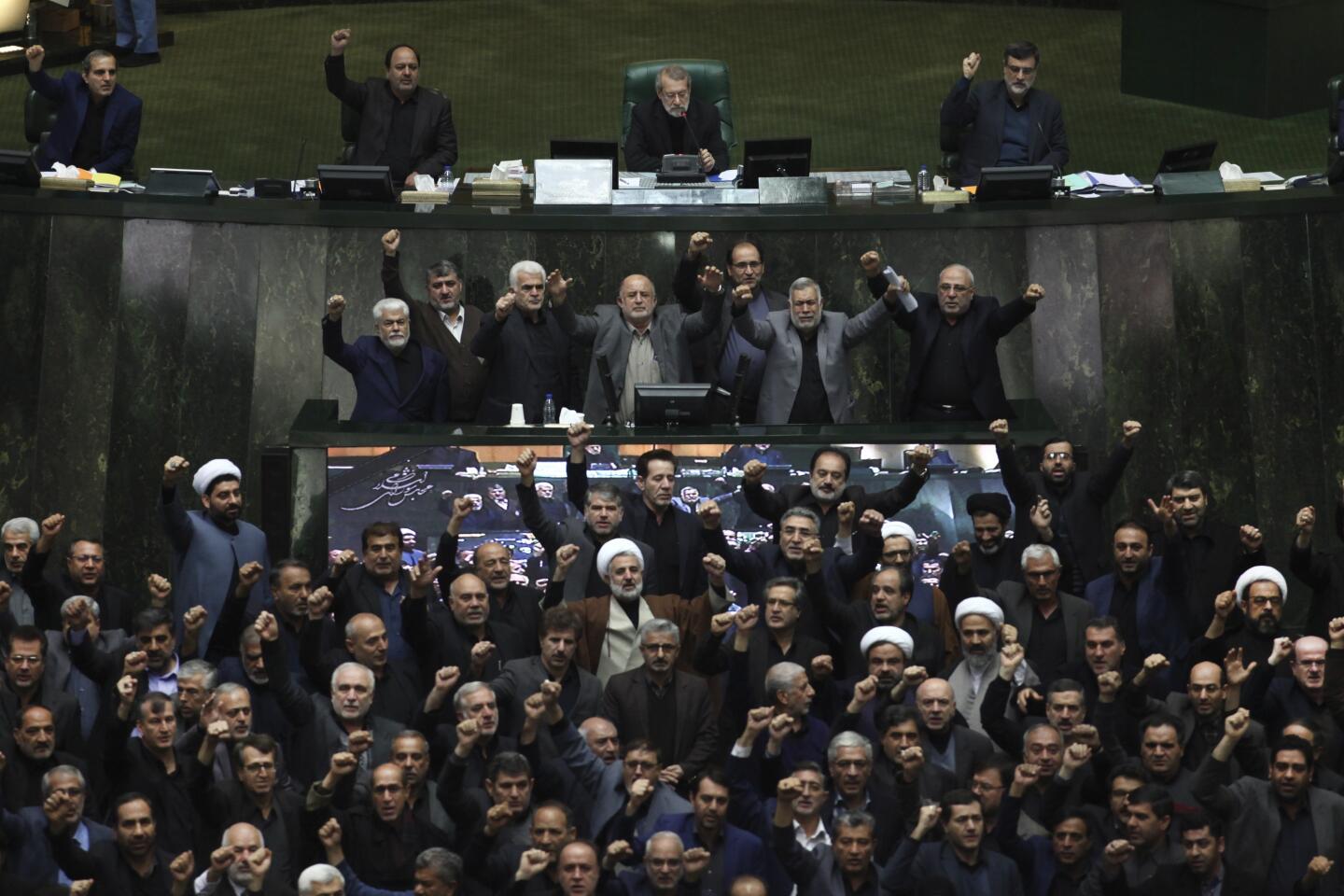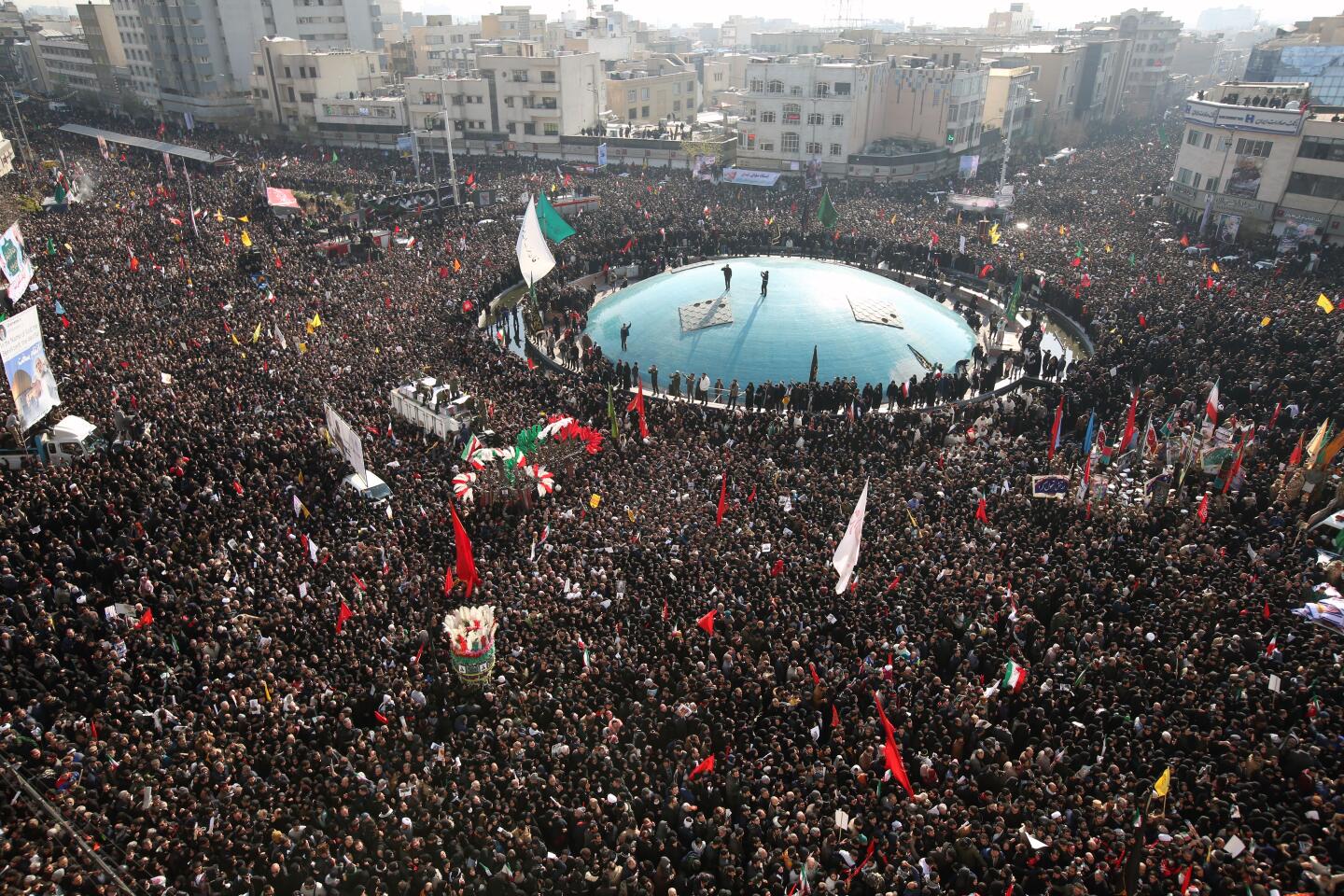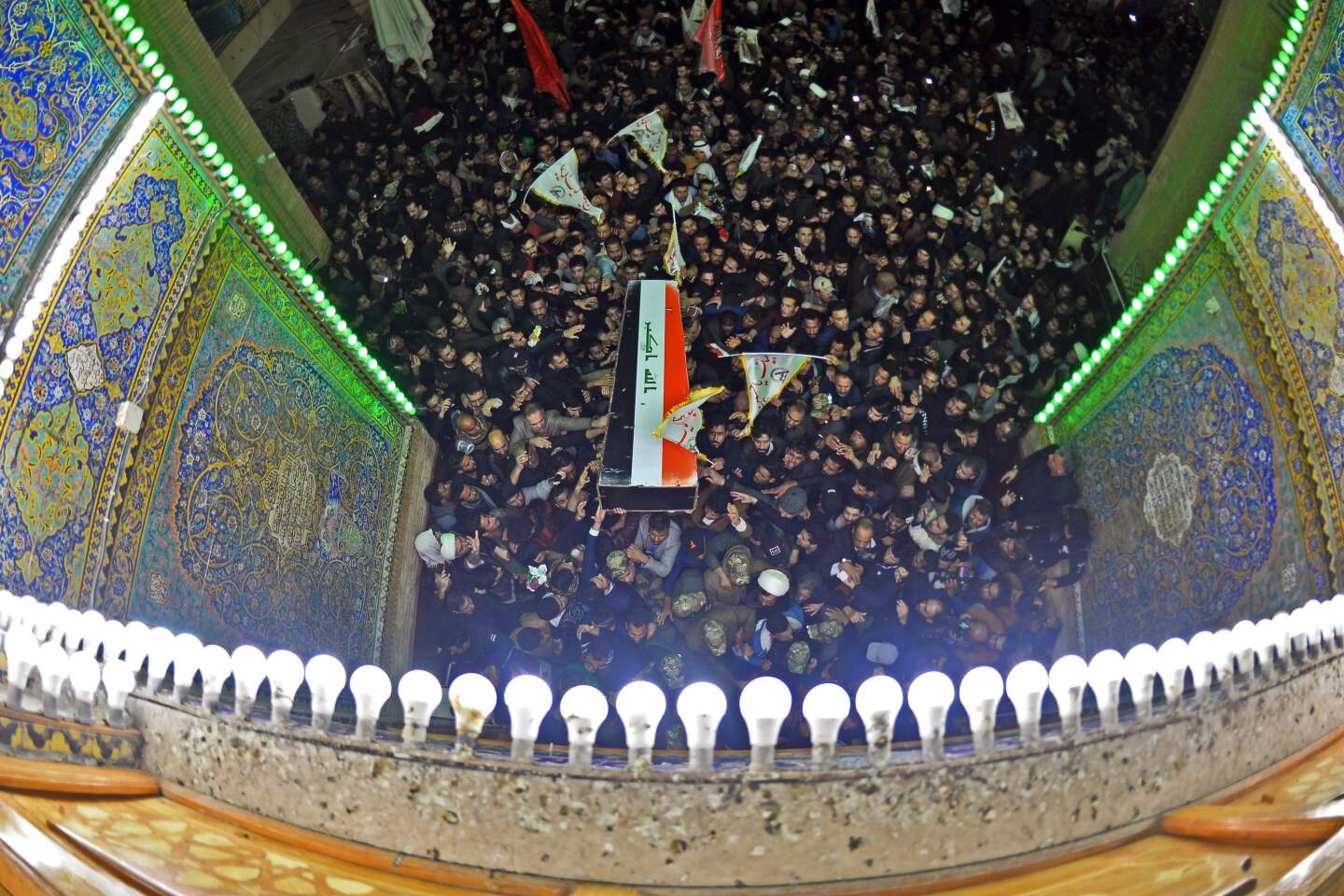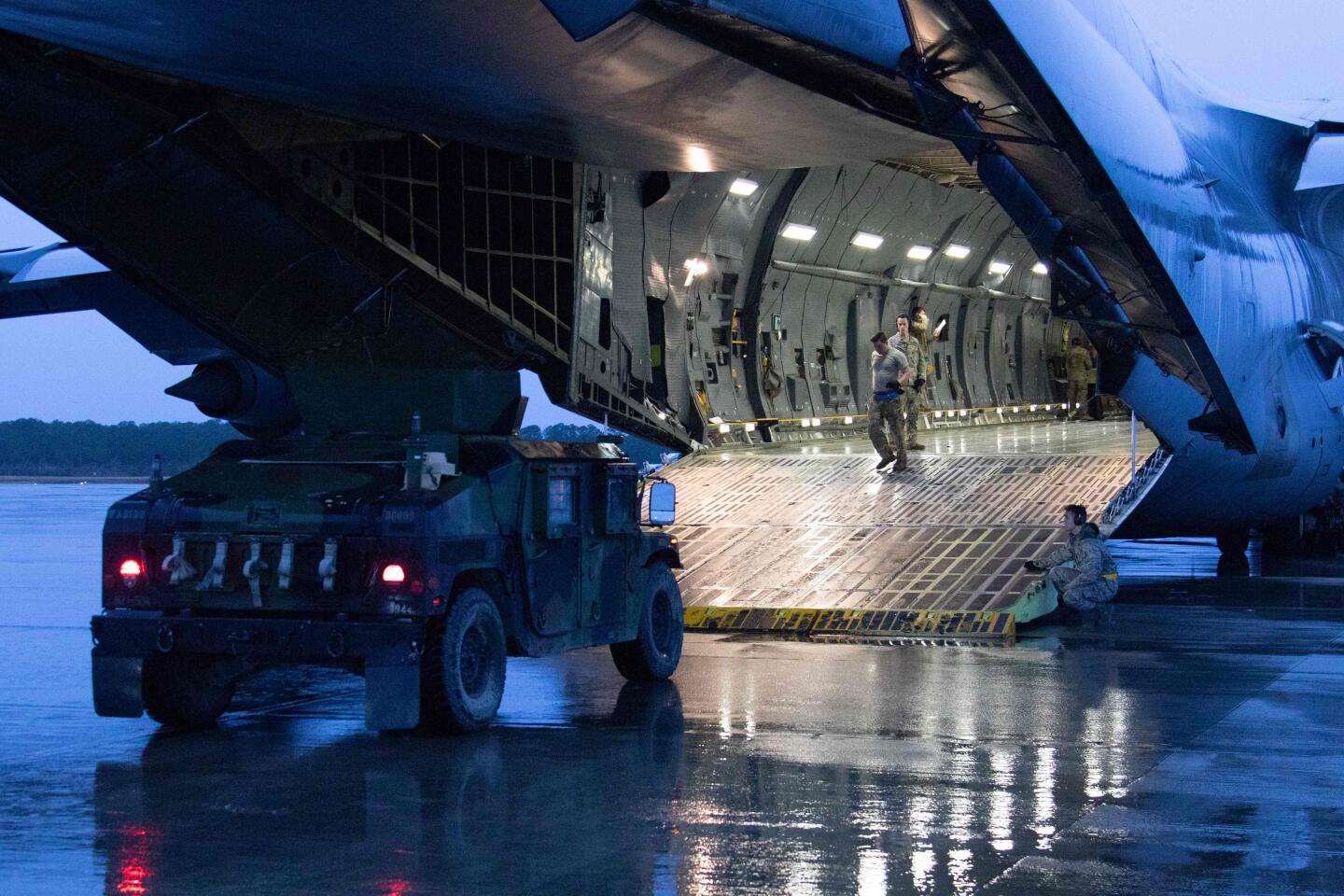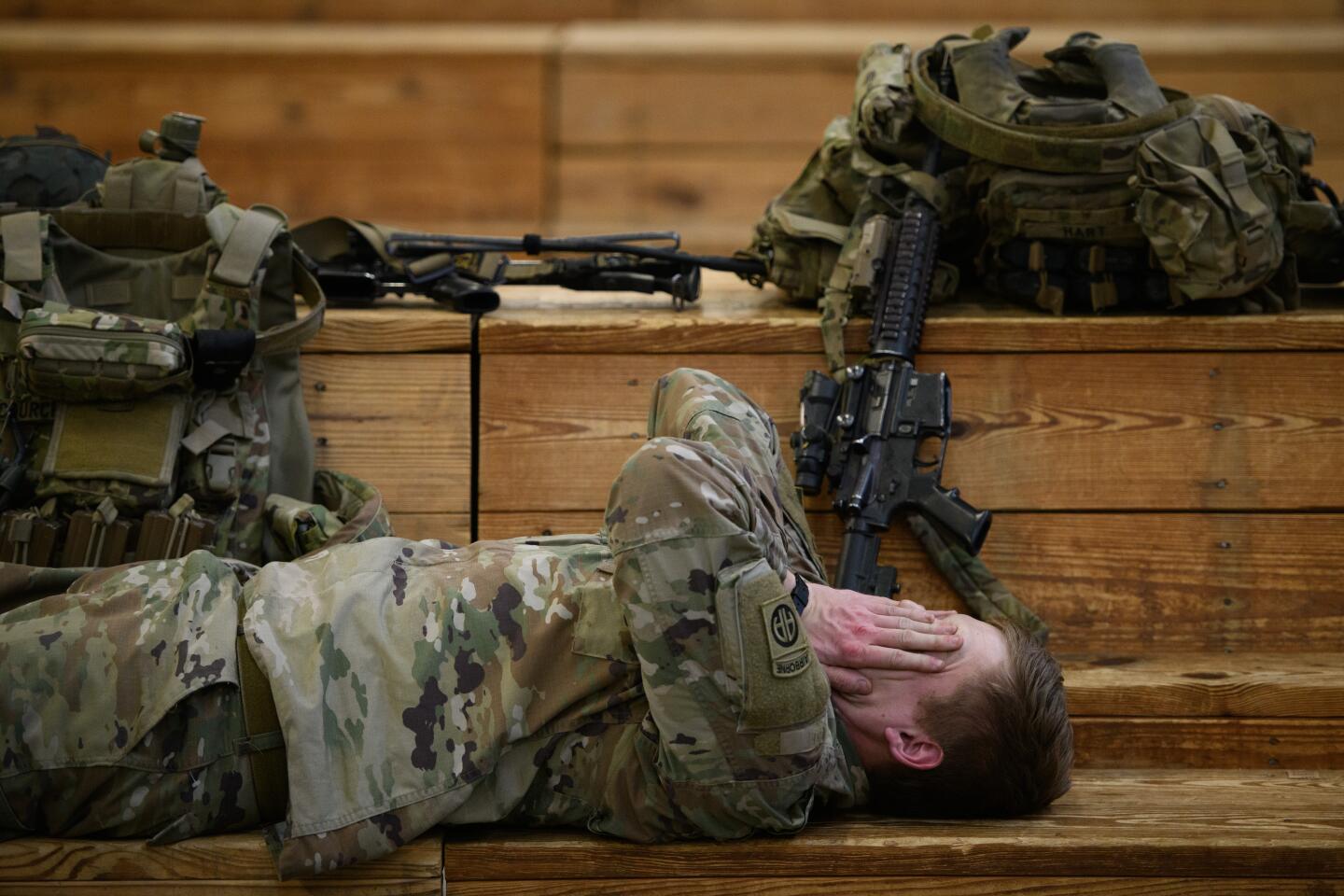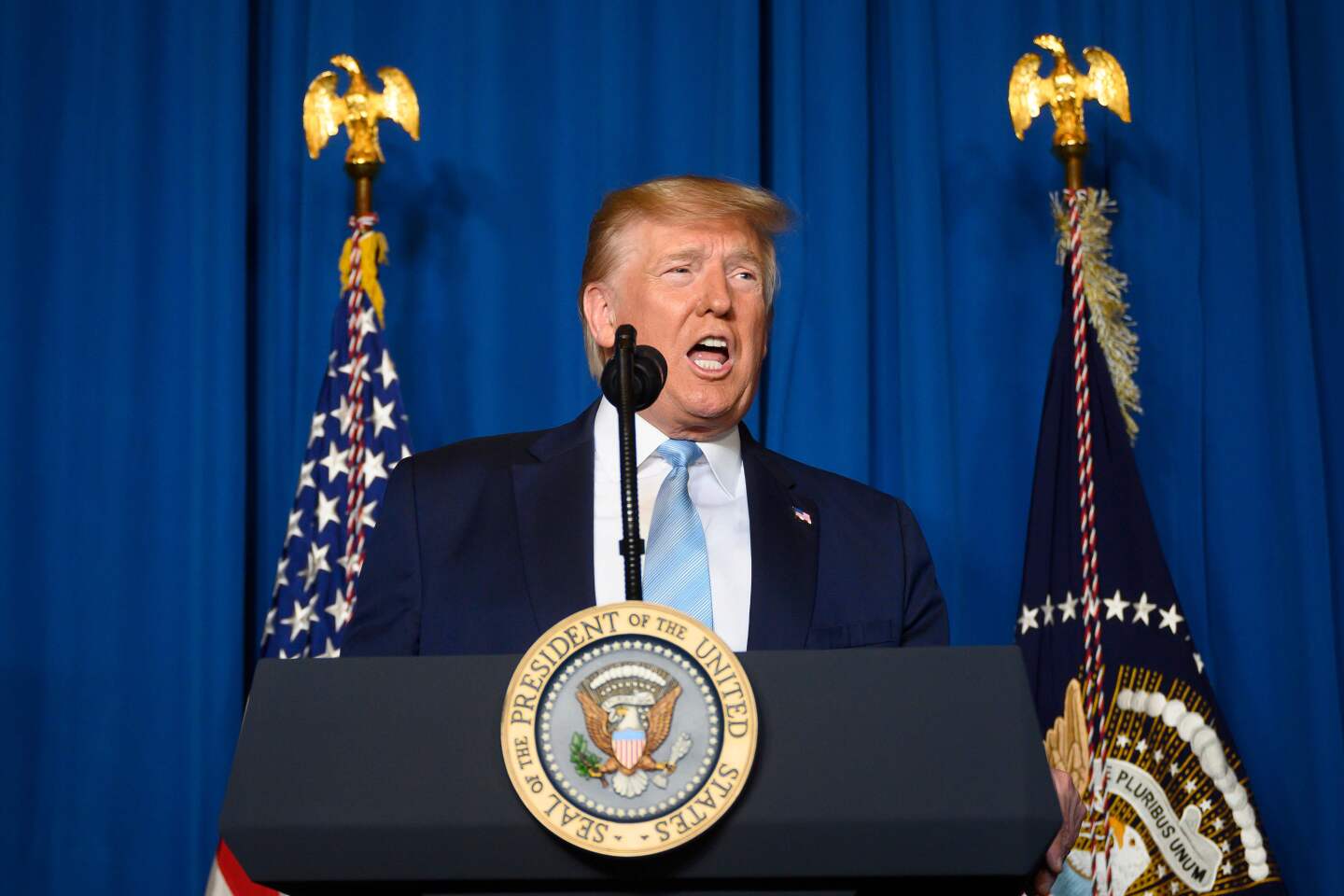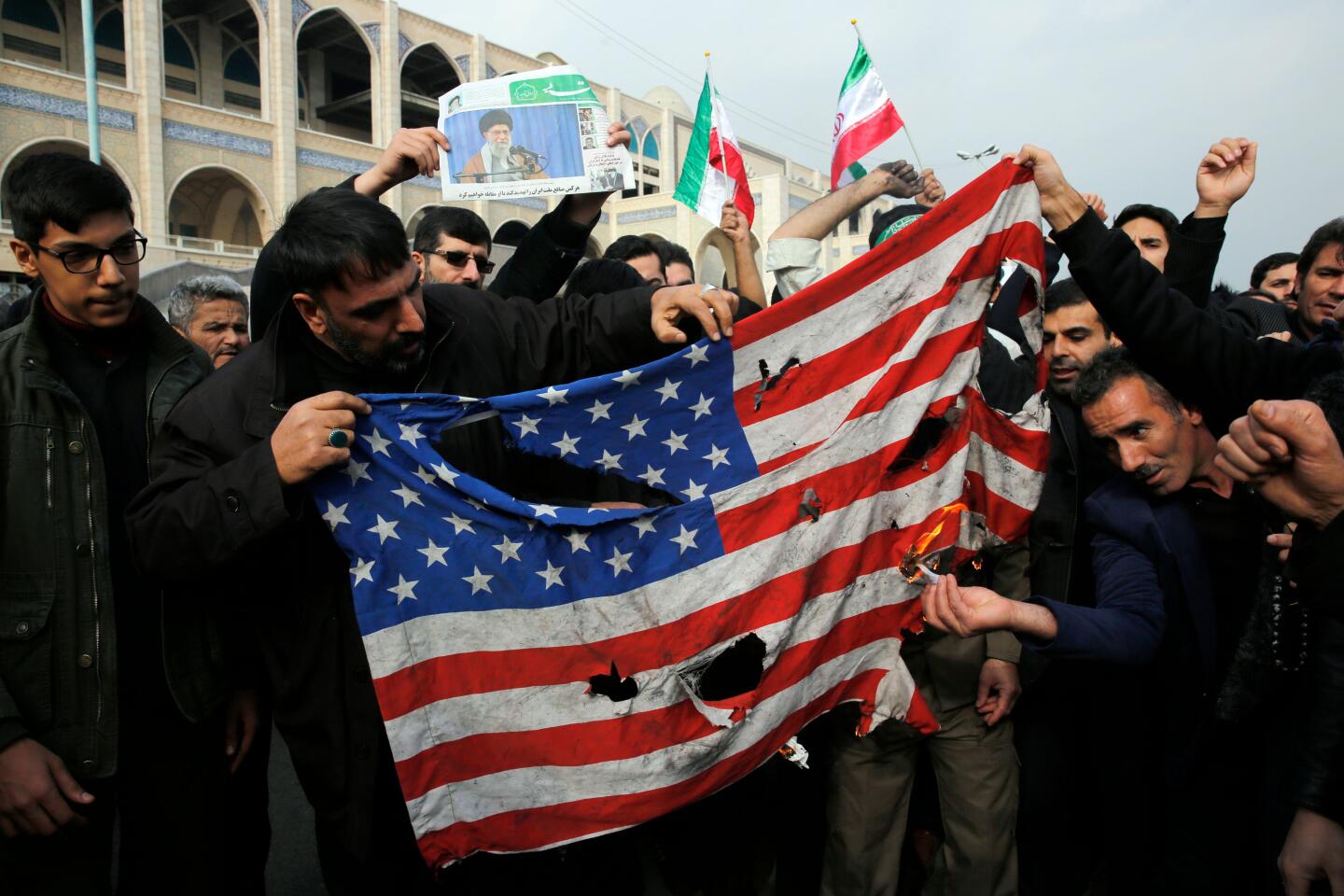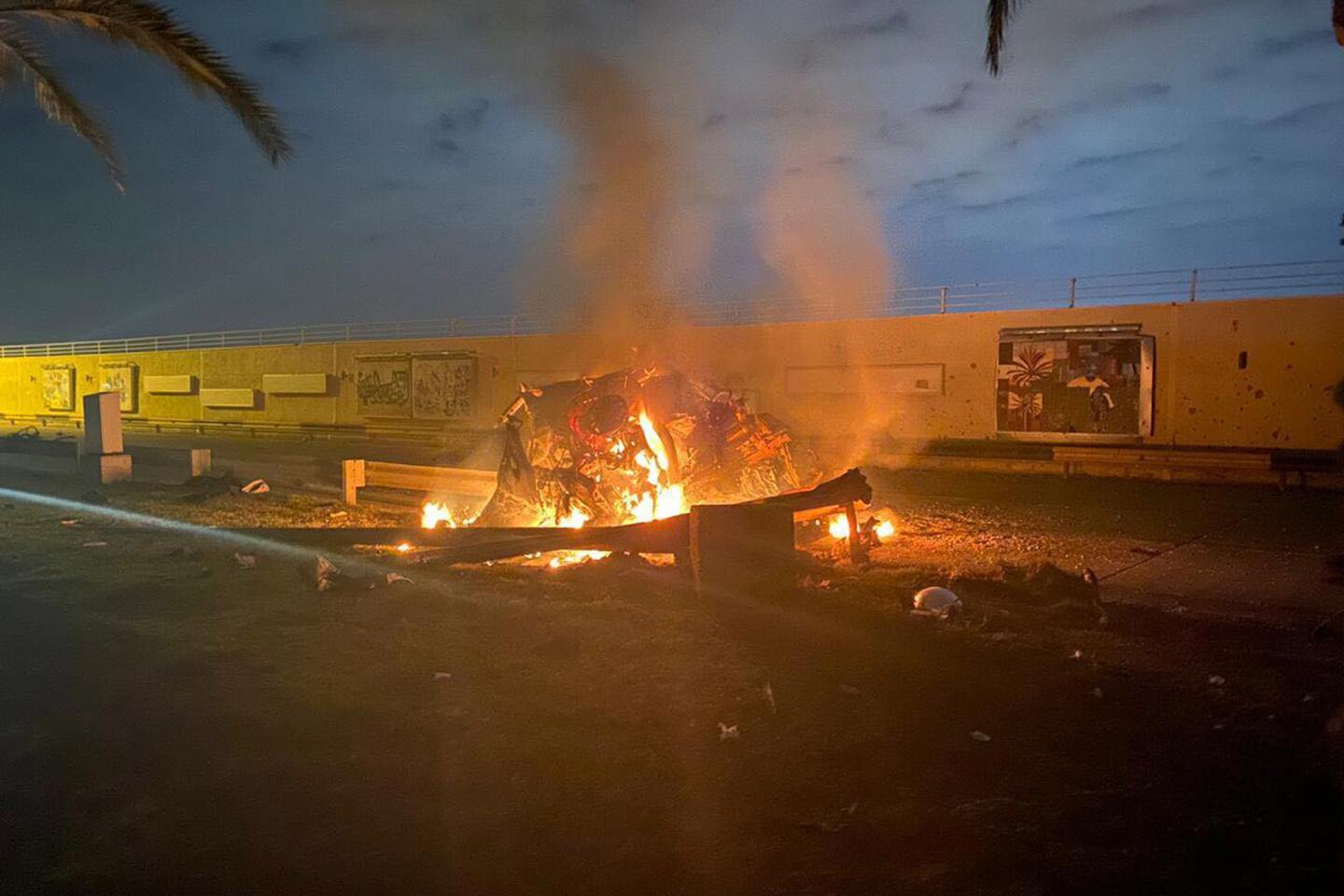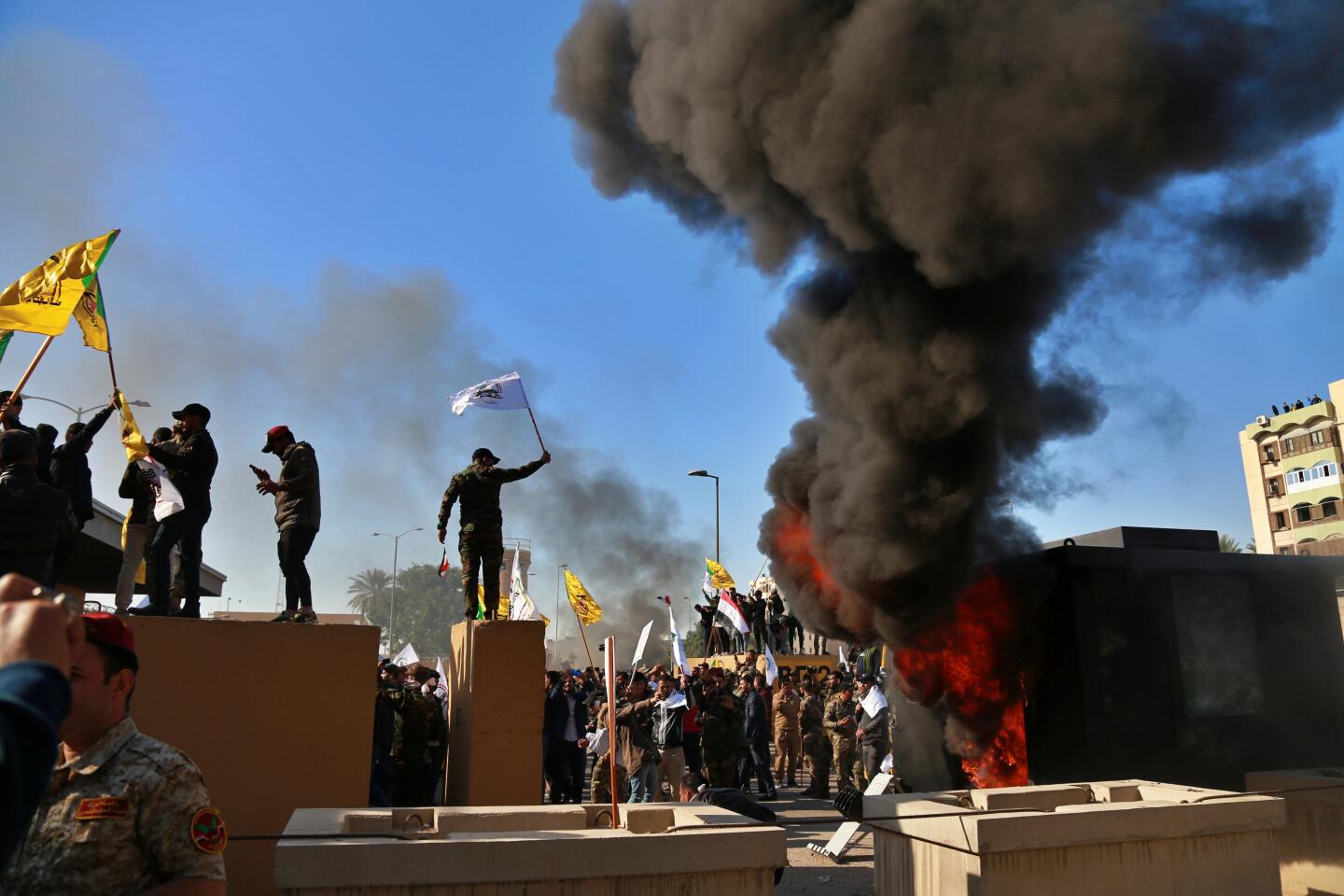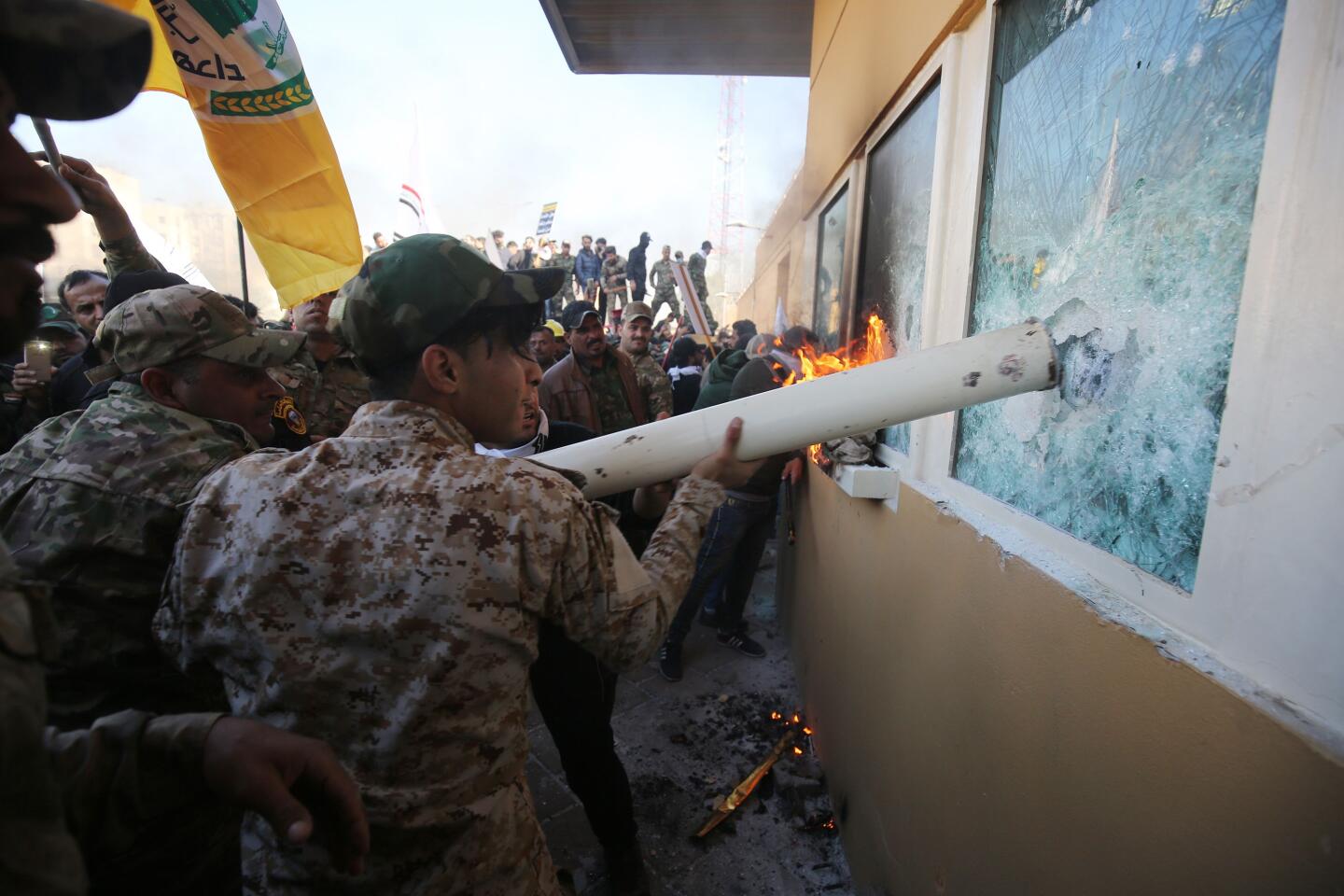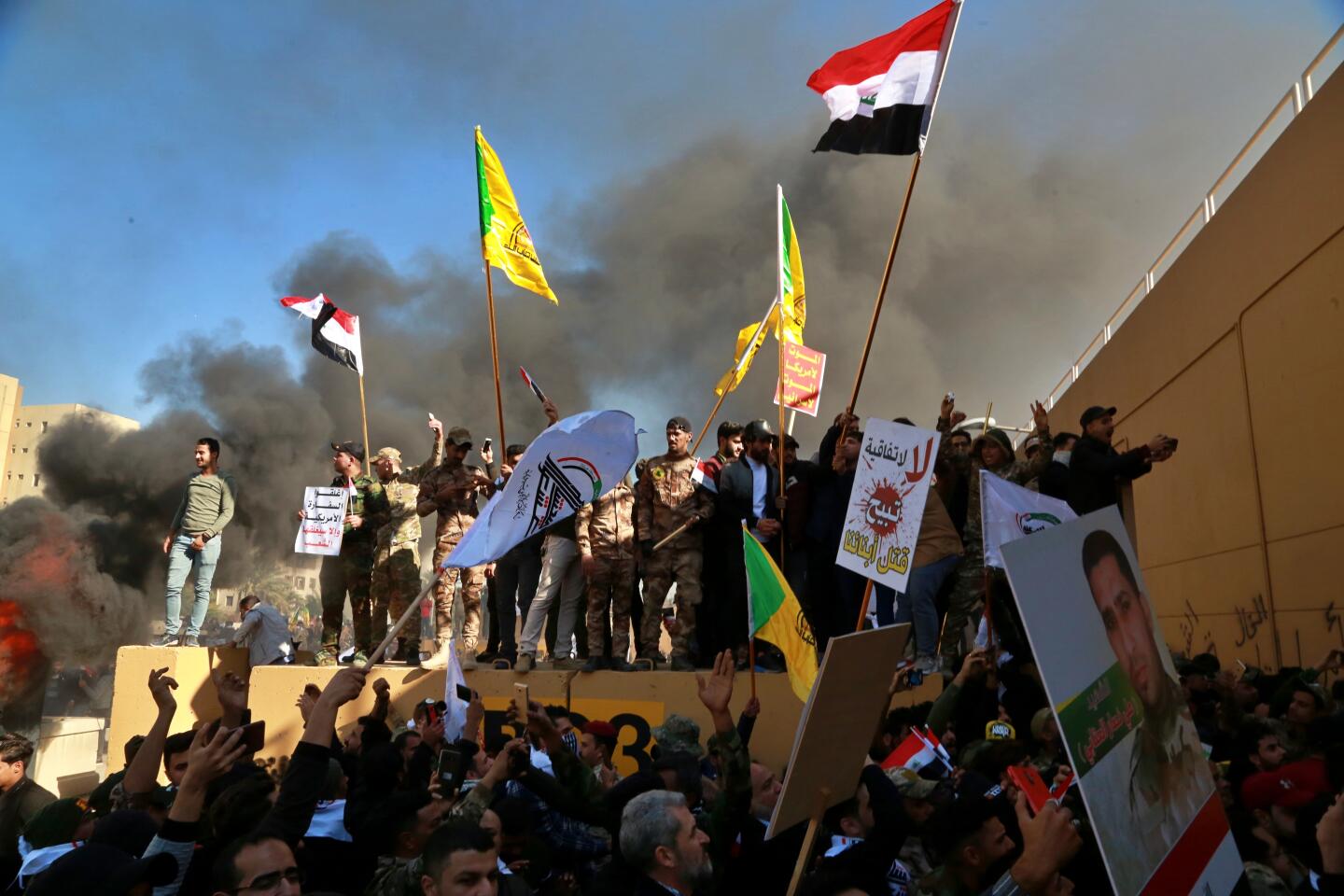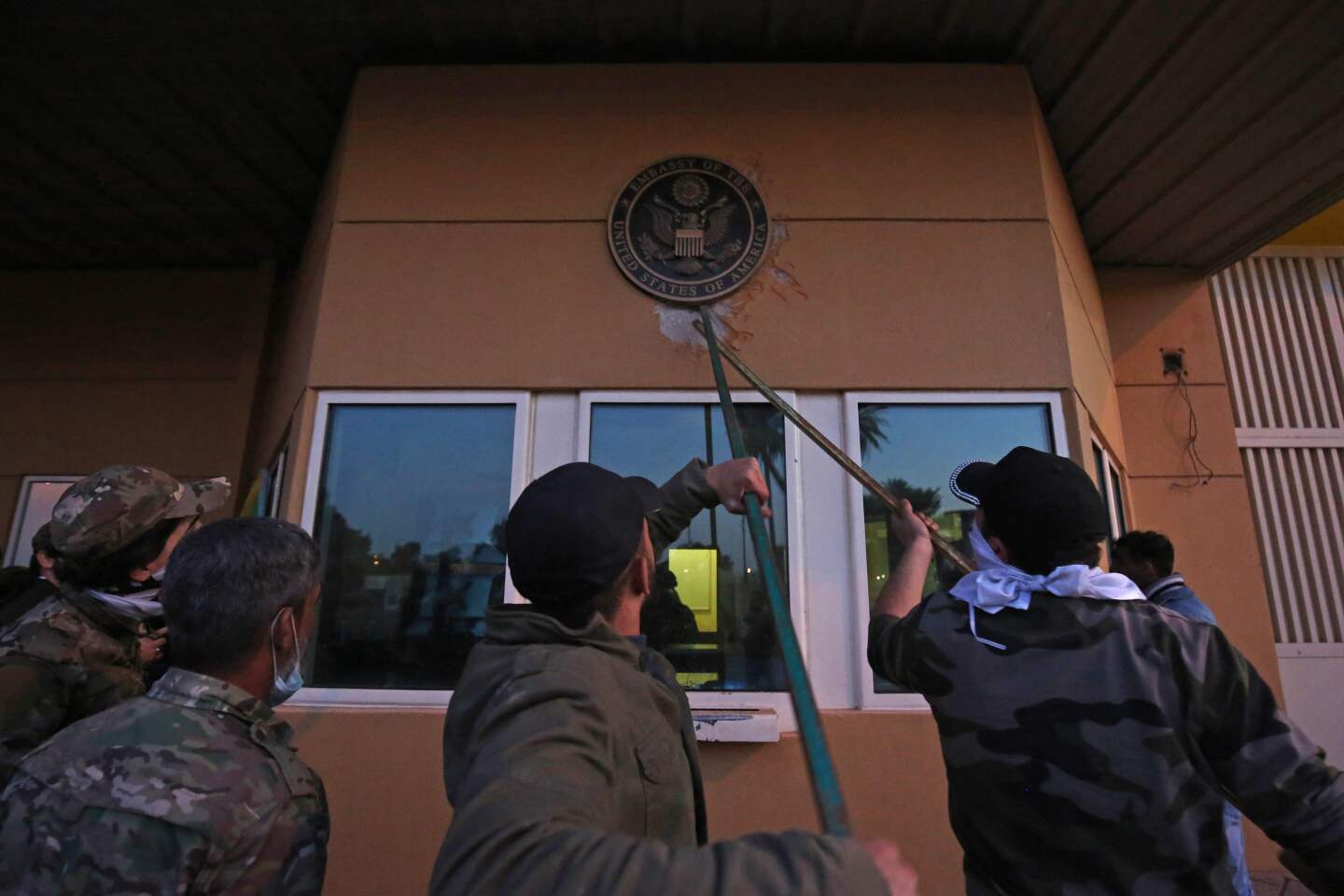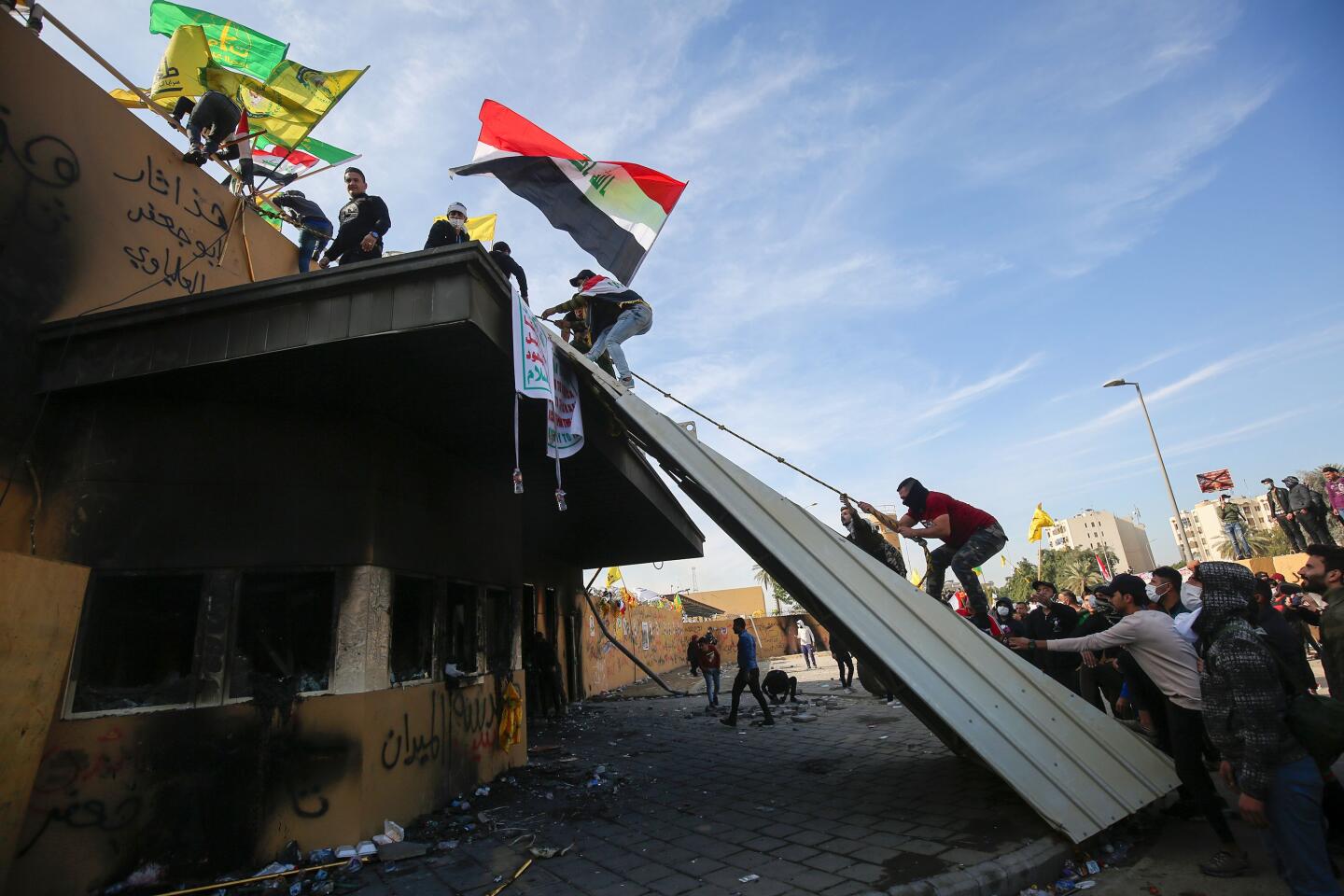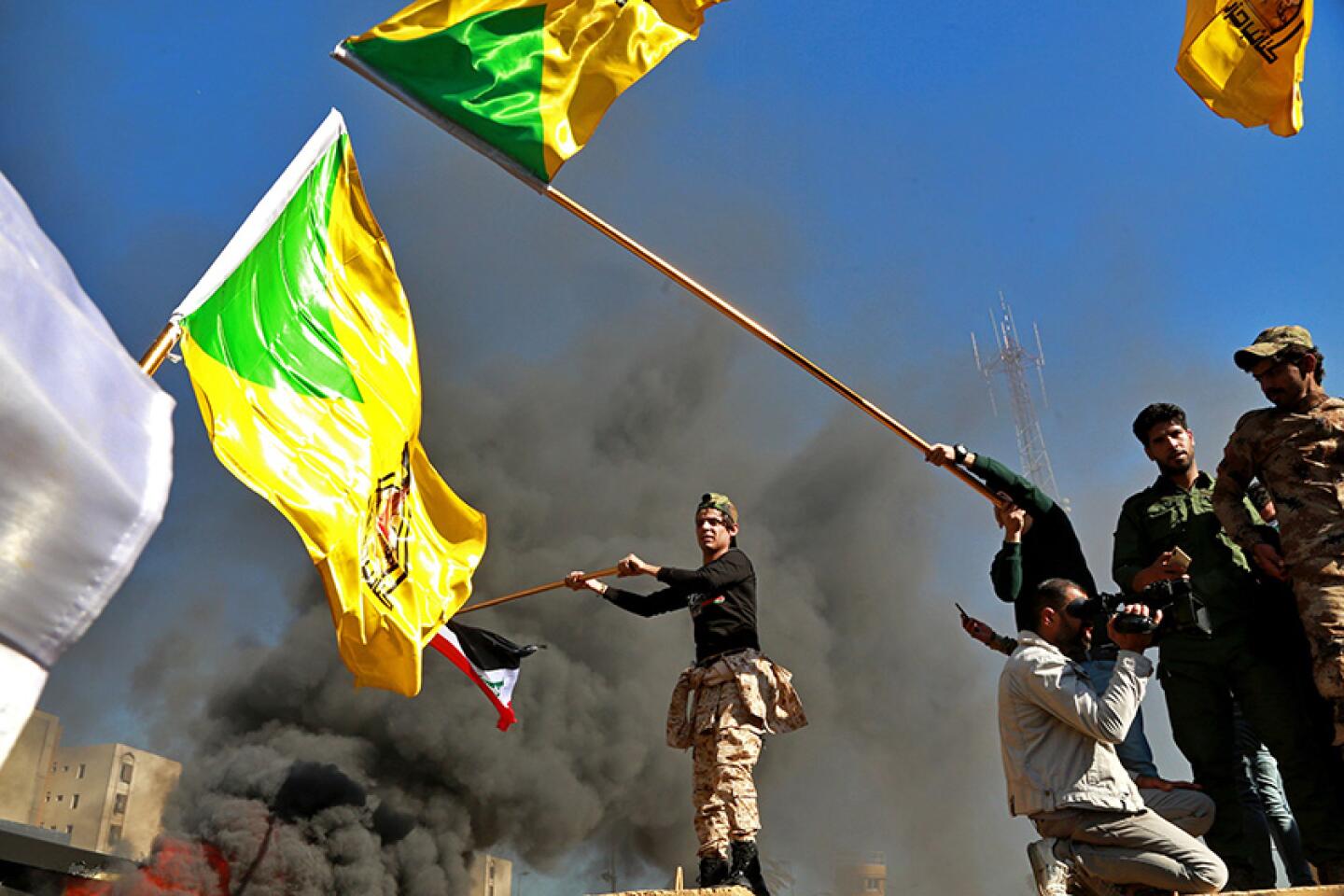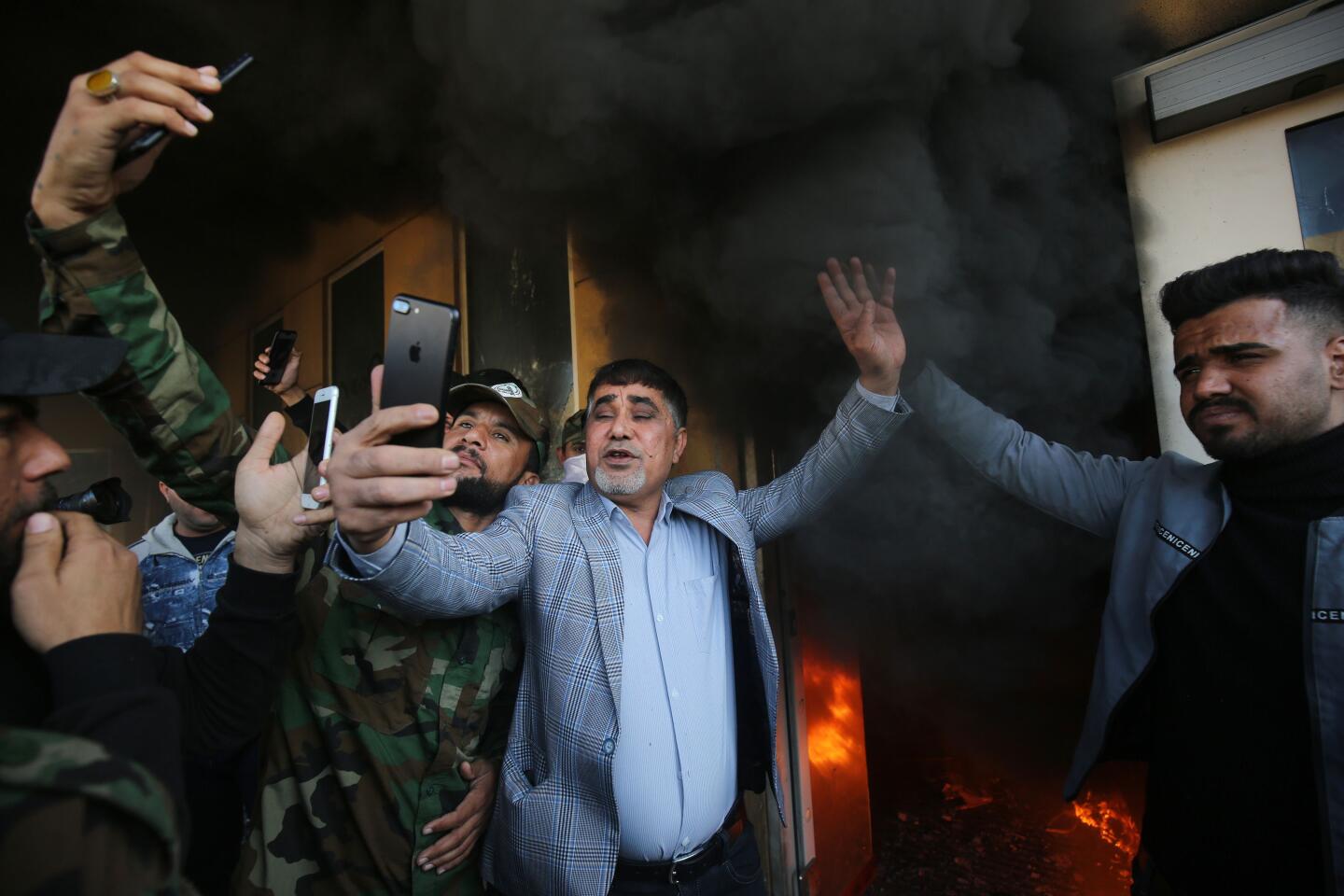Iran fires missiles at two bases housing U.S. forces in Iraq

- Share via
WASHINGTON — Iran launched 15 ballistic missiles at two military bases used by U.S. forces in Iraq, the Pentagon said Tuesday night, as long-simmering tensions between Washington and Tehran erupted into fiery explosions and fears of all-out war after the U.S. killing of a top Iranian general.
Eleven missiles hit the bases in western and northern Iraq and four failed in flight, according to a U.S. Defense official, who said there were no confirmed reports of American casualties in the audacious predawn attack.
Iran launched a series of missile attacks aimed at bases in Iraq.
There was no immediate U.S. military response or statement from President Trump after the barrage, although he tweeted that he would address the nation on Wednesday. Aides said he had been briefed and was monitoring the crisis with his national security advisors.
The U.S. has many options for retaliation if Trump chooses to escalate the conflict further. But in the immediate aftermath of the missile strikes, both Tehran and Washington appeared to signal a possible pause in the cycle of attack and retaliation in which they have been locked for the last several weeks.
“All is well!” Trump wrote in a Twitter message a few hours after the attack. “Missiles launched from Iran at two military bases located in Iraq. Assessment of casualties & damages taking place now. So far, so good! We have the most powerful and well equipped military anywhere in the world, by far! I will be making a statement tomorrow morning.”
Iran’s foreign minister, Mohammad Javad Zarif, sent his own tweet suggesting the missile strikes could be the beginning and end of Iran’s retaliation for the U.S. drone attack that killed Iranian Gen. Qassem Suleimani on Friday in Baghdad, an event that infuriated Iran and sparked fresh turmoil in the volatile region.
“Iran took & concluded proportionate measures in self-defense under Article 51 of UN Charter targeting [the] base from which cowardly armed attack against our citizens & senior officials were launched,” he said, referring to the sprawling Asad Air Base in western Iraq, which is a major base for U.S. drone attacks.
“We do not seek escalation or war, but will defend ourselves against any aggression,” he wrote.
Whether Zarif fully speaks for all factions of Iran’s government, however, is unclear. He has frequently been denounced by figures allied with the Islamic Revolutionary Guard Corps.

Trump’s advisors also have offered divided counsel over Iran. At least some administration hard-liners have openly rooted for a wider confrontation, seeing that as an opportunity to severely damage, or perhaps overthrow, Iran’s theocratic government, and at least one informal advisor called Tuesday night for Trump to hit Iran hard.
“If we don’t react, we’re incentivizing more” Iranian misconduct, Sean Hannity, one of Trump’s favorite TV commentators, said on his Fox TV program Tuesday night.
Despite his often bellicose language, however, Trump has repeatedly said his administration does “not seek regime change” in Iran. In June, when Iran shot down a U.S. drone, Trump stopped a planned retaliatory strike, noting that no Americans had been killed.
The Iranian missile strikes apparently mark the first time Tehran has directly attacked U.S. positions and openly acknowledged doing so. U.S. officials have frequently accused Iran of being behind attacks on American forces in Iraq, but those assaults generally involved Iranian-backed militias, not Iranian security forces.
Ten missiles hit the Asad Air Base in western Iraq’s Anbar province, which is used by U.S. and Iraqi troops. U.S. radar tracked the missiles in flight and as a result, personnel at the base had time to take cover before they struck, according to the defense official, who was not authorized to speak on the record. The U.S. made no effort to intercept the missiles, the official said.
Iranian state television reports the stampede took place in Kerman, hometown of Gen. Qassem Suleimani.
One missile hit the Combined Joint Operations Center in Irbil, in northern Iraq’s semiautonomous Kurdish region, where U.S. forces train Iraqi Kurdish fighters and run an air operations control center covering northern Iraq and parts of Syria.
The official said that U.S. Central Command was aware of reports of Iraqi casualties in Irbil but that they were unconfirmed.
Both bases were on high alert as U.S. and coalition forces braced for Tehran’s reprisals for the U.S. airstrike that killed Suleiman, the charismatic general who led Iran’s efforts to expand its influence across Iraq, Syria, Lebanon and Yemen with militant proxy forces.
Iranian state television called the missiles “harsh Iranian revenge” for Suleimani’s death and warned that if the United States launched a military retaliation, Tehran would escalate as well and the two longtime adversaries would face a wider war.
Iran announced the attack on state-run television, which showed video of what it said were “tens” of missile launches aimed at the bases. Roughly an hour later, state-run TV showed video of what it called a “second wave” of missiles being launched.
The first missiles were launched at 1:20 a.m. Wednesday, the Iranian broadcast said, noting that was the precise time that Suleimani “was martyred by the Americans” as he left Baghdad’s airport.
Pentagon spokesman Jonathan Hoffman subsequently confirmed the attacks. “It is clear that these missiles were launched from Iran,” he said.
“As we evaluate the situation and our response, we will take all necessary measures to protect and defend U.S. personnel, partners and allies in the region,” he added.
Iran’s Gen. Qassem Suleimani had already been glorified. In the aftermath of his death, Suleimani’s legacy is as potent as ever.
At least some U.S. analysts said that if Iran did not launch a follow-up attack, it might not generate a military response from the Trump administration.
“If there are no U.S. casualties, and this is the extent of Iranian retaliation, then the U.S. does not need to escalate,” said Faysal Itani, deputy director of the Center for Global Policy, a Washington think tank that specializes in Muslim politics.
Mark Dubowitz of the Foundation in Defense of Democracies, a Washington group that has advocated a hard line against Iran, tweeted Tuesday night asking if it was “plausible that this could be the extent” of Iran’s retaliation for Suleimani’s death.
Iran’s supreme leader, Ayatollah Ali Khamenei, “said he would attack [the] military directly. He seems to have done that,” Dubowitz wrote. If there are “no US casualties, is the smart play not to respond and wait to see what else they do?”
A representative of Khamenei tweeted the image of the Iranian flag after the missiles were launched. It echoed Trump’s tweet of the U.S. flag when Suleimani was killed.
James Carafano, a foreign policy expert at the Heritage Foundation in Washington, said Americans still have an overwhelming military advantage, one that could dissuade the Iranians from trying to draw the U.S. into an even deeper conflict.
“The problem with escalating is, where does that go?” he asked.
If the U.S. unleashes its own missiles, possible targets could include the Iranian bases that launched the missiles, and military command-and-control facilities.
In addition to fighters and bombers at bases in Qatar and the United Arab Emirates, a U.S. aircraft carrier, the Truman, is deployed in the Arabian Gulf with two destroyers that are capable of firing Tomahawk missiles. The Air Force also has bomber planes based in the United States that could be used.
By any standard, the Iranian attack is a major escalation of a struggle between Iran and the U.S. that was conducted for years in the shadows, or via proxy forces, but that quickly spiraled out of control after Trump authorized the killing of Suleimani, one of Iran’s most powerful military commanders.
Defense Secretary Mark Esper, Secretary of State Michael R. Pompeo, Chairman of the Joint Chiefs Gen. Mark Milley and CIA Director Gina Haspel are scheduled to brief members of Congress behind closed doors Wednesday about the Suleimani killing, but they undoubtedly will be asked about Iran’s missile attack.
The House Foreign Affairs Committee called a hearing on Iran for Jan. 14 and asked Pompeo to testify.
House Speaker Nancy Pelosi (D-San Francisco) was notified of the missile strikes in a note handed to her during a meeting of House Democratic leaders, according to Democrats in the room.
“She told us it had happened and [added:] ‘We’re all praying,’” said Rep. Debbie Dingell (D-Mich.), who was in the meeting.
The attack overshadowed, at least for the moment, Trump’s pending impeachment trial in the Senate. It also added a new challenge for Democrats battling for attention and votes in the presidential primaries that start next month.
“What’s happening in Iraq and Iran today was predictable,” former Vice President Joe Biden said at a campaign event in Philadelphia when news of the attack broke. “Not exactly what’s happening but the chaos that’s ensuing,” he said, faulting Trump for withdrawing from the 2015 Iran nuclear deal and for the drone strike that killed Suleimani.
Sen. Rand Paul (R-Ky.), a frequent critic of U.S. military intervention, voiced concerns that the violence was spiraling.
“I am praying for the safety of our troops in Iraq tonight,” he tweeted. “We need to stop the escalation before it leads to another endless war in the Middle East.”
Abu Mahdi Muhandis, a onetime political dissident, lawmaker and militia leader, was one of Iraq’s most powerful men.
Earlier, Trump shifted his justification for authorizing the killing of Suleimani as the top U.S. national security official belatedly provided classified briefings to congressional leaders about the administration’s claim that the Iranian had been planning an imminent attack on Americans.
Trump and his aides previously insisted that Friday’s deadly drone strike was intended to stop the Quds Force commander from killing “hundreds” of Americans.
But his death in Baghdad instead saw Iranian leaders vow to “set ablaze” scores of Western targets, prompted ally Iraq’s threat to expel U.S. military forces and pushed the Pentagon to beef up American troops and bolster defenses in the region.
With tensions rising, and unable to convincingly argue that Americans were safer, Trump and his aides instead pointed to Suleimani’s role supplying insurgents who killed hundreds of U.S. troops during the Iraq war.
“It was retaliation,” Trump said Tuesday.
The change in emphasis fueled growing concerns about the administration’s still-murky strategy for dealing with Iran. It also underscored the unique challenge for a president who has uttered thousands of falsehoods since taking office as he and his aides sought to reassure Americans they can navigate a major foreign policy crisis, largely of their own making, before it spirals into all-out war.
“I don’t think any American president can simply say to the world, ‘Trust me,’” said Richard Haass, president of the nonpartisan Council on Foreign Relations. “Trump has the added problem of his own record with the truth.”
“If you’re trying to justify something that could ultimately take you to war, you better damn well do that as quickly and directly as you can,” said Leon E. Panetta, who served as secretary of Defense and CIA director under President Obama. “The last thing that you need is to have an American public that questions why the hell we’re going to war.”
Trump chose to attack Suleimani after military leaders outline Iranian plans, officials say.
For the second day in a row, senior U.S. officials were forced to walk back Trump’s threats to bomb Iranian cultural sites, a potential war crime, if Iran launches retaliatory attacks. As criticism poured in, Trump appeared to back down, saying for the first time that he would not deliberately target Iran’s antiquities.
“If that’s what the law is, I like to obey the law,” he said.
In Baghdad, Iraq’s government demanded clarification over whether the approximately 5,200 U.S. troops in Iraq were making plans to pull out after receiving a letter — twice — from a U.S. commander that the Pentagon said was sent in error.
Iraqi officials said the letter was delivered around 8 p.m., but the Arabic translation did not match the English-language version. Iraqi officials pointed out the discrepancy and later received a correct translation via official channels.
“It wasn’t a matter of a paper falling from a photocopier or something that came by accident,” Iraqi Prime Minister Adel Abdul Mahdi said in a speech Tuesday, adding that the Pentagon’s subsequent claims that the letter was a draft had bewildered the Iraqis.
“OK, this is a draft,” he said. “But we got it. So how should we behave?”
Abdul Mahdi urged Trump to withdraw U.S. troops, but Defense Secretary Mark Esper — holding his second news conference in two days — repeated his assertion that no pullout was underway or had been ordered.
“A draft, unsigned letter does not constitute a policy change,” Esper said. “And there is no signed letter, to the best of my knowledge. I’ve asked the question.”
Joseph Maguire, the acting director of national intelligence, provided classified briefings Tuesday to the leaders of the House and Senate, and the chairs and ranking members of the Intelligence committees on the evidence available before last week’s drone strike. Normally the so-called Gang of Eight is informed before such a sensitive military operation takes place.
At the State Department, Pompeo told reporters that Suleimani had posed an “imminent threat” to Americans. But he declined to provide evidence of the threat, instead blaming the veteran commander for a “terror campaign” as he oversaw Iranian military and proxy-force operations across the Middle East.
He dismissed Iraq’s claim that Suleimani had flown into Baghdad for talks aimed at easing tensions with Saudi Arabia, its chief regional rival, as part of an initiative to ease tensions. “Anyone here believe that?” Pompeo said.
Cloud, Bierman and Megerian reported from Washington and Parvini from Los Angeles. Times staff writers Jennifer Haberkorn and Tracy Wilkinson in Washington and Nabih Bulos in Baghdad contributed to this report.
More to Read
Get the L.A. Times Politics newsletter
Deeply reported insights into legislation, politics and policy from Sacramento, Washington and beyond. In your inbox twice per week.
You may occasionally receive promotional content from the Los Angeles Times.
